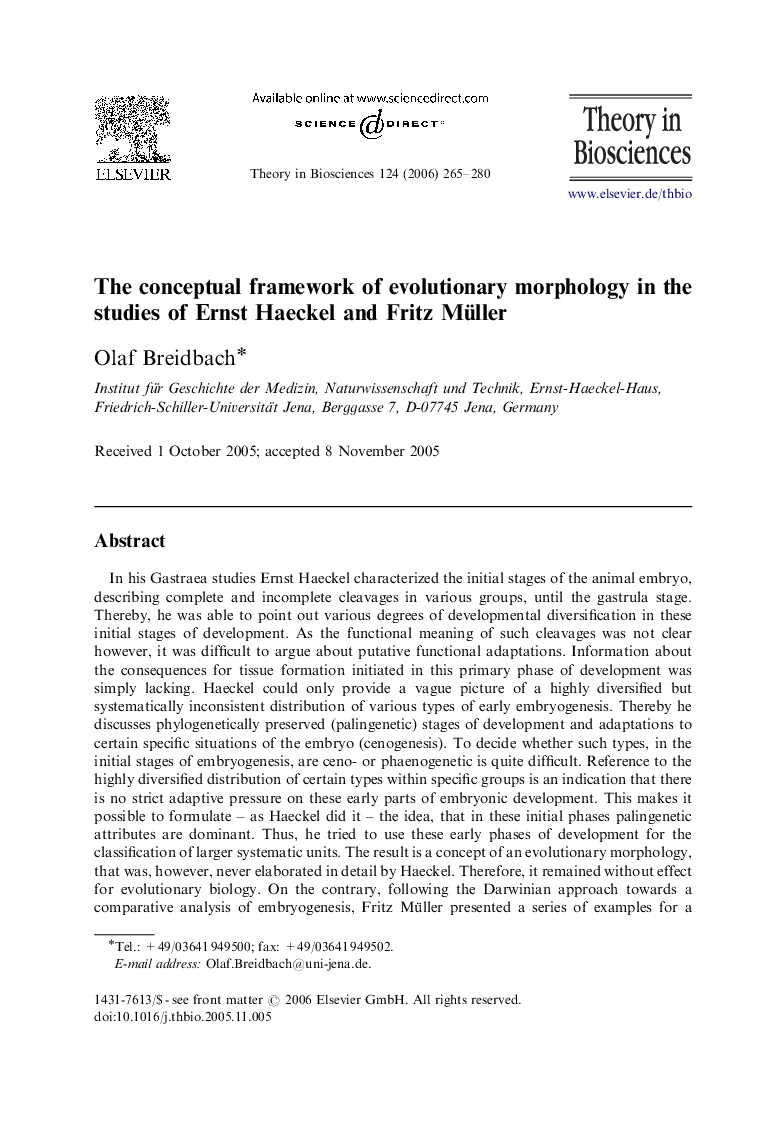| کد مقاله | کد نشریه | سال انتشار | مقاله انگلیسی | نسخه تمام متن |
|---|---|---|---|---|
| 4503109 | 1624176 | 2006 | 16 صفحه PDF | دانلود رایگان |
عنوان انگلیسی مقاله ISI
The conceptual framework of evolutionary morphology in the studies of Ernst Haeckel and Fritz Müller
دانلود مقاله + سفارش ترجمه
دانلود مقاله ISI انگلیسی
رایگان برای ایرانیان
موضوعات مرتبط
مهندسی و علوم پایه
ریاضیات
مدلسازی و شبیه سازی
پیش نمایش صفحه اول مقاله

چکیده انگلیسی
In his Gastraea studies Ernst Haeckel characterized the initial stages of the animal embryo, describing complete and incomplete cleavages in various groups, until the gastrula stage. Thereby, he was able to point out various degrees of developmental diversification in these initial stages of development. As the functional meaning of such cleavages was not clear however, it was difficult to argue about putative functional adaptations. Information about the consequences for tissue formation initiated in this primary phase of development was simply lacking. Haeckel could only provide a vague picture of a highly diversified but systematically inconsistent distribution of various types of early embryogenesis. Thereby he discusses phylogenetically preserved (palingenetic) stages of development and adaptations to certain specific situations of the embryo (cenogenesis). To decide whether such types, in the initial stages of embryogenesis, are ceno- or phaenogenetic is quite difficult. Reference to the highly diversified distribution of certain types within specific groups is an indication that there is no strict adaptive pressure on these early parts of embryonic development. This makes it possible to formulate - as Haeckel did it - the idea, that in these initial phases palingenetic attributes are dominant. Thus, he tried to use these early phases of development for the classification of larger systematic units. The result is a concept of an evolutionary morphology, that was, however, never elaborated in detail by Haeckel. Therefore, it remained without effect for evolutionary biology. On the contrary, following the Darwinian approach towards a comparative analysis of embryogenesis, Fritz Müller presented a series of examples for a comparative developmental biology that allowed one to interpret certain morphological characteristics as the outcome of common evolutionary histories within different species. For various crustacean species, he was able to demonstrate that certain attributes are not to be characterized as functionally relevant adaptations, but are evolutionarily inherited.
ناشر
Database: Elsevier - ScienceDirect (ساینس دایرکت)
Journal: Theory in Biosciences - Volume 124, Issues 3â4, 1 March 2006, Pages 265-280
Journal: Theory in Biosciences - Volume 124, Issues 3â4, 1 March 2006, Pages 265-280
نویسندگان
Olaf Breidbach,